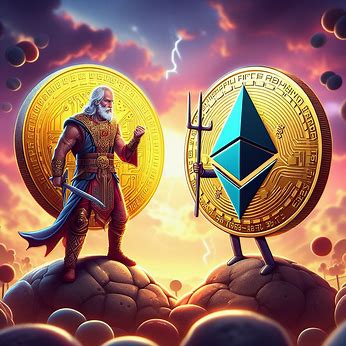Have you heard about Ethereum but aren’t quite sure what it is? You’re not alone. Ethereum is a complex technology, but understanding its basics is very important. So, here is the answer to the question “how do you explain Ethereum to a beginner?”.
What is Ethereum?
On answering how do you explain Ethereum to a beginner?, the first thing required to be done is to explain what ethereum is.
Ethereum is a decentralized, open-source blockchain platform that enables developers to build and deploy smart contracts and decentralized applications (dApps). It was launched in 2015 by Vitalik Buterin, a programmer and co-founder of Bitcoin Magazine. Ethereum’s goal is to create a decentralized internet where users have control over their data and interactions, rather than relying on centralized entities.
How does Ethereum differ from Bitcoin?
While both Ethereum and Bitcoin are blockchain-based platforms, they serve different purposes:
- Bitcoin is primarily used as a digital currency for financial transactions. Its blockchain is designed to record and verify transactions securely and transparently.
- Ethereum, on the other hand, is designed to facilitate the creation and execution of smart contracts and dApps. While it also has its own cryptocurrency, Ether (ETH), the primary focus is on enabling developers to build decentralized applications on top of the Ethereum blockchain.
What are smart contracts?
Another thing that must not be left out when explaining how do you explain Ethereum to a beginner? is what smart contracts are.
Smart contracts are self-executing contracts with the terms of the agreement directly written into code. They automatically enforce the terms of the contract when predetermined conditions are met, preventing the need for intermediaries. Smart contracts are stored on the Ethereum blockchain, ensuring that they are transparent, immutable, and secure.
Some key features of smart contracts include:
1. Immutability: Once deployed, the contract’s code cannot be altered. This ensures that the terms of the agreement remain unchanged and tamper-proof.
2. Transparency: All parties can view the contract’s terms and conditions, promoting trust and accountability.
3. Trustless execution: The contract executes automatically without the need for third-party involvement, reducing the risk of fraud or manipulation.
How does Ethereum work?
Ethereum operates on a decentralized network of computers, known as nodes, that work together to validate transactions and maintain the integrity of the blockchain. Here’s a more detailed explanation of the process:
- A user initiates a transaction or deploys a smart contract on the Ethereum network using their Ethereum wallet.
- The transaction is broadcast to the network and picked up by miners, who are nodes that validate transactions and add them to the blockchain.
- Miners validate the transaction by solving complex mathematical problems, a process known as proof-of-work (PoW). This process ensures that the transaction is legitimate and follows the rules of the Ethereum network.
- Once the transaction is validated, it is added to a block along with other verified transactions. Each block contains a unique code, called a hash, that links it to the previous block, forming a chain of blocks (hence the term “blockchain”).
- The block is then added to the Ethereum blockchain, creating a permanent and immutable record of the transaction. This record is distributed across all nodes in the network, ensuring that it cannot be altered or deleted.
Related: USDC vs. USDT: Which Stablecoin is A Better Choice in 2024
What is Ether (ETH)?
Ether (ETH) is the native cryptocurrency of the Ethereum platform. It serves two main purposes:
- As a digital currency for financial transactions on the Ethereum network. Users can send and receive ETH to pay for goods and services, or to trade on cryptocurrency exchanges.
- As “gas” to pay for the computational resources required to execute smart contracts and dApps. When a user deploys a smart contract or interacts with a dApp, they must pay a certain amount of ETH to cover the cost of processing the transaction.
Real-world applications of Ethereum
Ethereum’s smart contract functionality has enabled the development of a number of decentralized applications across various industries, including:
1. Decentralized Finance (DeFi): Ethereum is the foundation for many DeFi projects, such as decentralized exchanges, lending platforms, and stablecoins, which aim to provide financial services without intermediaries. DeFi applications allow users to borrow, lend, trade, and invest in cryptocurrencies without relying on traditional financial institutions.
2. Non-Fungible Tokens (NFTs): NFTs are unique digital assets that represent ownership of digital or physical items, such as artwork, music, or collectibles. Ethereum’s ERC-721 standard has become the most popular way to create and trade NFTs, enabling creators to monetize their digital content and providing collectors with verifiable ownership.
3. Supply Chain Management: Ethereum can be used to create transparent and immutable records of goods as they move through the supply chain, improving efficiency and reducing fraud. By using smart contracts, stakeholders can automate processes, track the provenance of goods, and ensure compliance with regulations.
4. Identity Management: Ethereum-based solutions can provide secure, decentralized identity management, giving users greater control over their personal data. Decentralized identity platforms allow users to selectively share their information with third parties, reducing the risk of data breaches and privacy violations.
5. Gaming: Ethereum has become a popular platform for decentralized gaming applications, enabling players to own and trade in-game assets securely. Decentralized games often incorporate NFTs to represent unique items or characters, creating new opportunities for player engagement and monetization.
Key Takeaways
1. Ethereum is a decentralized, open-source blockchain platform that enables the creation and execution of smart contracts and decentralized applications (dApps).
2. Unlike Bitcoin, which is primarily used as a digital currency, Ethereum focuses on facilitating the development of dApps and smart contracts.
3. Smart contracts are self-executing contracts with the terms of the agreement written directly into code, ensuring transparency, immutability, and trustless execution.
4. Ethereum operates on a decentralized network of nodes that work together to validate transactions and maintain the integrity of the blockchain through a proof-of-work (PoW) consensus mechanism.
5. Ether (ETH) is the native cryptocurrency of the Ethereum platform, serving as a digital currency for financial transactions and as “gas” to pay for the execution of smart contracts and dApps.
6. Ethereum has enabled the development of a wide range of decentralized applications across industries, including decentralized finance (DeFi), non-fungible tokens (NFTs), supply chain management, identity management, and gaming.
7. The Ethereum ecosystem is continuously growing, with major upgrades like Ethereum 2.0 and Layer 2 solutions aimed at improving scalability, security, and sustainability.
8. Ethereum’s future is designed by its community through the Ethereum Improvement Proposal (EIP) process, ensuring that the platform remains adaptable and responsive to the needs of its users.
9. As the adoption and usage of Ethereum grow, it is expected to make an impact on the adoption of blockchain technology across various industries and shape the future of decentralized technologies.
Frequently Asked Questions
1. What is the difference between Ethereum and Ethereum Classic?
Ethereum and Ethereum Classic are two separate blockchain platforms that share a common history. In 2016, the Ethereum community split due to a disagreement over how to handle a major hack. Ethereum Classic maintained the original blockchain, while Ethereum implemented a hard fork to restore the stolen funds. Today, Ethereum is the more widely adopted platform, with a larger developer community and more significant updates.
2. How do I buy Ethereum?
To buy Ethereum, you’ll need to create an account on a cryptocurrency exchange that supports ETH. Some popular exchanges include Coinbase, Binance, and Kraken. Once your account is set up and verified, you can deposit funds and use them to purchase ETH. Alternatively, you can buy ETH through peer-to-peer platforms like LocalCryptos or use a cryptocurrency ATM.
3. What is a gas fee in Ethereum?
In Ethereum, gas refers to the cost required to perform a transaction or execute a smart contract on the network. Gas fees are paid in Ether (ETH) and are used to compensate miners for the computational resources they contribute to the network. The gas fee varies depending on the complexity of the transaction and the current network congestion.
4. What is an Ethereum wallet?
An Ethereum wallet is a software program or hardware device that allows you to store, send, and receive ETH and other Ethereum-based tokens. Wallets come in various forms, including desktop, mobile, web, and hardware wallets. Some popular Ethereum wallets include MyEtherWallet, MetaMask, and Ledger Nano S. It’s necessary to choose a wallet that prioritizes security and fits your specific needs.
5. How long does an Ethereum transaction take?
The time it takes for an Ethereum transaction to be confirmed depends on several factors, including network congestion and the gas fee you’re willing to pay. On average, Ethereum transactions are confirmed within seconds to a few minutes. However, during periods of high network activity, transactions may take longer to process.
6. Can I mine Ethereum?
Yes, you can mine Ethereum using specialized computer hardware called mining rigs. However, as the Ethereum network has grown, mining has become increasingly competitive and resource-intensive. Most individual miners now join mining pools to combine their computational power and increase their chances of earning ETH rewards.










